Business in Practice: Company Analysis and Organizational Structures
VerifiedAdded on 2023/01/10
|9
|2755
|38
Report
AI Summary
This report provides a comprehensive overview of business practices, exploring diverse company types, including micro, small, medium, and large businesses. It delves into different business structures such as sole trader, partnership, limited liability, public limited liability, and cooperatives, highlighting their characteristics and implications. The report further examines organizational structures, contrasting functional and divisional structures and their impact on firm productivity. Additionally, it applies PESTLE analysis to the UK market, assessing the political, economic, social, technological, legal, and environmental factors influencing businesses. The analysis provides insights into how these external factors shape business operations and strategies, making it a valuable resource for understanding the business environment.
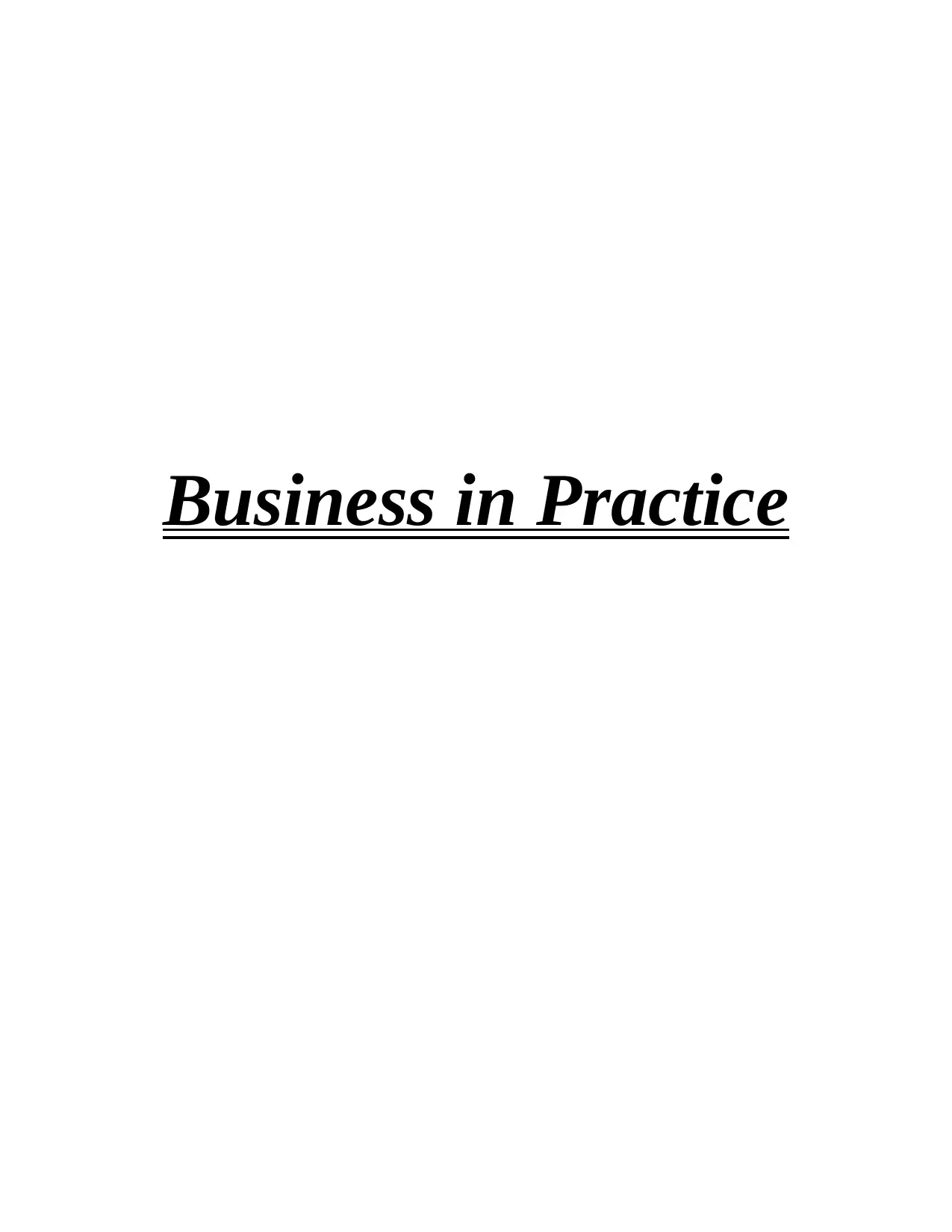
Business in Practice
Paraphrase This Document
Need a fresh take? Get an instant paraphrase of this document with our AI Paraphraser
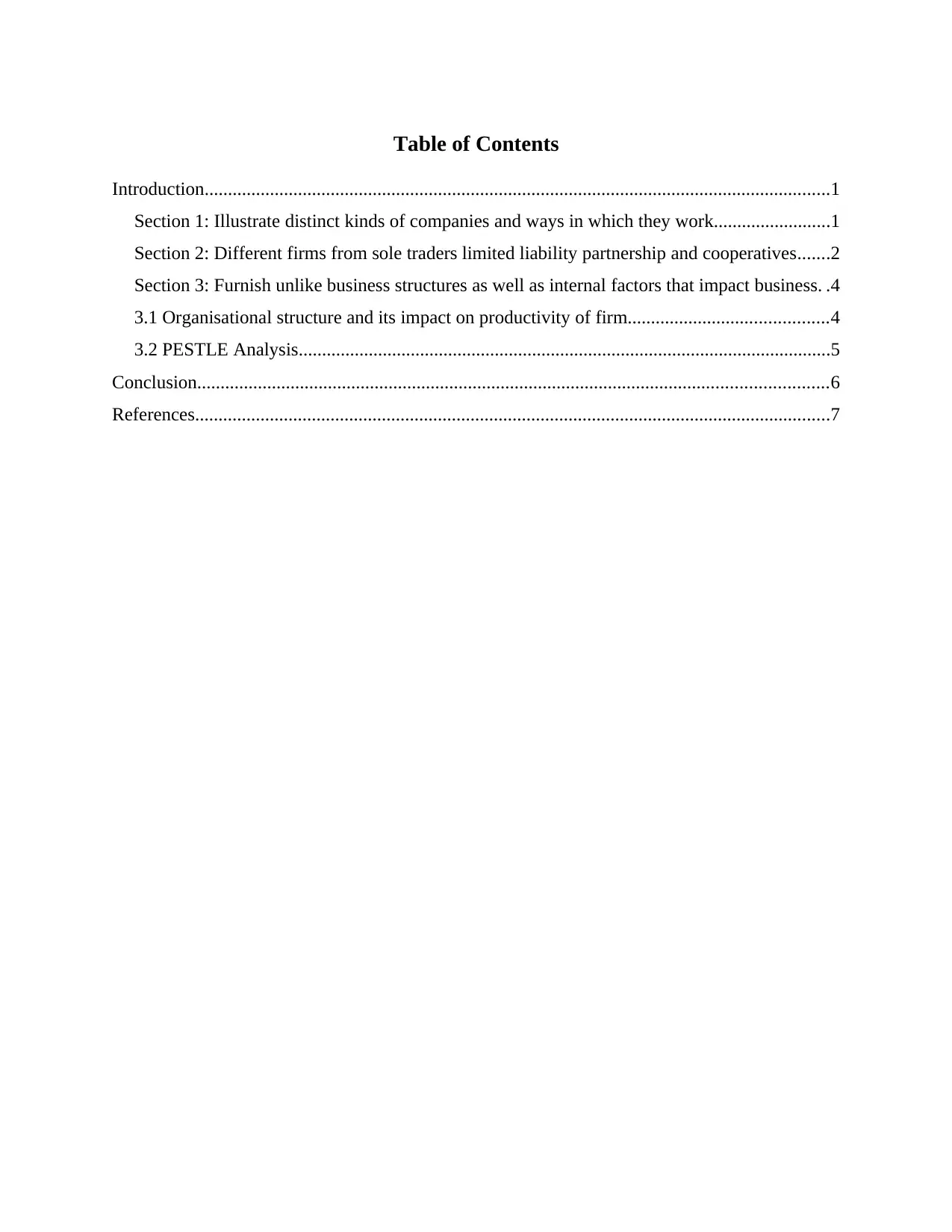
Table of Contents
Introduction......................................................................................................................................1
Section 1: Illustrate distinct kinds of companies and ways in which they work.........................1
Section 2: Different firms from sole traders limited liability partnership and cooperatives.......2
Section 3: Furnish unlike business structures as well as internal factors that impact business. .4
3.1 Organisational structure and its impact on productivity of firm...........................................4
3.2 PESTLE Analysis..................................................................................................................5
Conclusion.......................................................................................................................................6
References........................................................................................................................................7
Introduction......................................................................................................................................1
Section 1: Illustrate distinct kinds of companies and ways in which they work.........................1
Section 2: Different firms from sole traders limited liability partnership and cooperatives.......2
Section 3: Furnish unlike business structures as well as internal factors that impact business. .4
3.1 Organisational structure and its impact on productivity of firm...........................................4
3.2 PESTLE Analysis..................................................................................................................5
Conclusion.......................................................................................................................................6
References........................................................................................................................................7
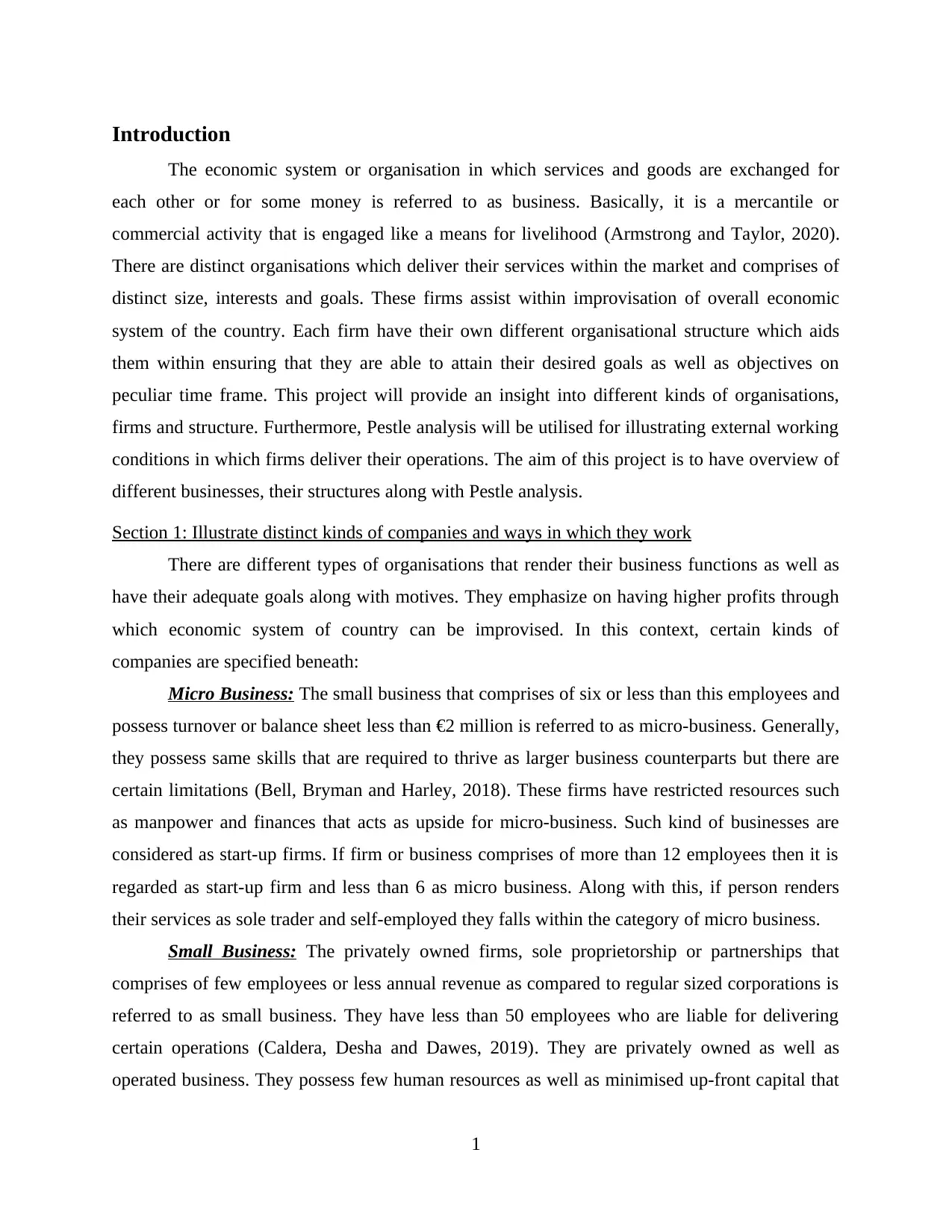
Introduction
The economic system or organisation in which services and goods are exchanged for
each other or for some money is referred to as business. Basically, it is a mercantile or
commercial activity that is engaged like a means for livelihood (Armstrong and Taylor, 2020).
There are distinct organisations which deliver their services within the market and comprises of
distinct size, interests and goals. These firms assist within improvisation of overall economic
system of the country. Each firm have their own different organisational structure which aids
them within ensuring that they are able to attain their desired goals as well as objectives on
peculiar time frame. This project will provide an insight into different kinds of organisations,
firms and structure. Furthermore, Pestle analysis will be utilised for illustrating external working
conditions in which firms deliver their operations. The aim of this project is to have overview of
different businesses, their structures along with Pestle analysis.
Section 1: Illustrate distinct kinds of companies and ways in which they work
There are different types of organisations that render their business functions as well as
have their adequate goals along with motives. They emphasize on having higher profits through
which economic system of country can be improvised. In this context, certain kinds of
companies are specified beneath:
Micro Business: The small business that comprises of six or less than this employees and
possess turnover or balance sheet less than €2 million is referred to as micro-business. Generally,
they possess same skills that are required to thrive as larger business counterparts but there are
certain limitations (Bell, Bryman and Harley, 2018). These firms have restricted resources such
as manpower and finances that acts as upside for micro-business. Such kind of businesses are
considered as start-up firms. If firm or business comprises of more than 12 employees then it is
regarded as start-up firm and less than 6 as micro business. Along with this, if person renders
their services as sole trader and self-employed they falls within the category of micro business.
Small Business: The privately owned firms, sole proprietorship or partnerships that
comprises of few employees or less annual revenue as compared to regular sized corporations is
referred to as small business. They have less than 50 employees who are liable for delivering
certain operations (Caldera, Desha and Dawes, 2019). They are privately owned as well as
operated business. They possess few human resources as well as minimised up-front capital that
1
The economic system or organisation in which services and goods are exchanged for
each other or for some money is referred to as business. Basically, it is a mercantile or
commercial activity that is engaged like a means for livelihood (Armstrong and Taylor, 2020).
There are distinct organisations which deliver their services within the market and comprises of
distinct size, interests and goals. These firms assist within improvisation of overall economic
system of the country. Each firm have their own different organisational structure which aids
them within ensuring that they are able to attain their desired goals as well as objectives on
peculiar time frame. This project will provide an insight into different kinds of organisations,
firms and structure. Furthermore, Pestle analysis will be utilised for illustrating external working
conditions in which firms deliver their operations. The aim of this project is to have overview of
different businesses, their structures along with Pestle analysis.
Section 1: Illustrate distinct kinds of companies and ways in which they work
There are different types of organisations that render their business functions as well as
have their adequate goals along with motives. They emphasize on having higher profits through
which economic system of country can be improvised. In this context, certain kinds of
companies are specified beneath:
Micro Business: The small business that comprises of six or less than this employees and
possess turnover or balance sheet less than €2 million is referred to as micro-business. Generally,
they possess same skills that are required to thrive as larger business counterparts but there are
certain limitations (Bell, Bryman and Harley, 2018). These firms have restricted resources such
as manpower and finances that acts as upside for micro-business. Such kind of businesses are
considered as start-up firms. If firm or business comprises of more than 12 employees then it is
regarded as start-up firm and less than 6 as micro business. Along with this, if person renders
their services as sole trader and self-employed they falls within the category of micro business.
Small Business: The privately owned firms, sole proprietorship or partnerships that
comprises of few employees or less annual revenue as compared to regular sized corporations is
referred to as small business. They have less than 50 employees who are liable for delivering
certain operations (Caldera, Desha and Dawes, 2019). They are privately owned as well as
operated business. They possess few human resources as well as minimised up-front capital that
1
⊘ This is a preview!⊘
Do you want full access?
Subscribe today to unlock all pages.

Trusted by 1+ million students worldwide
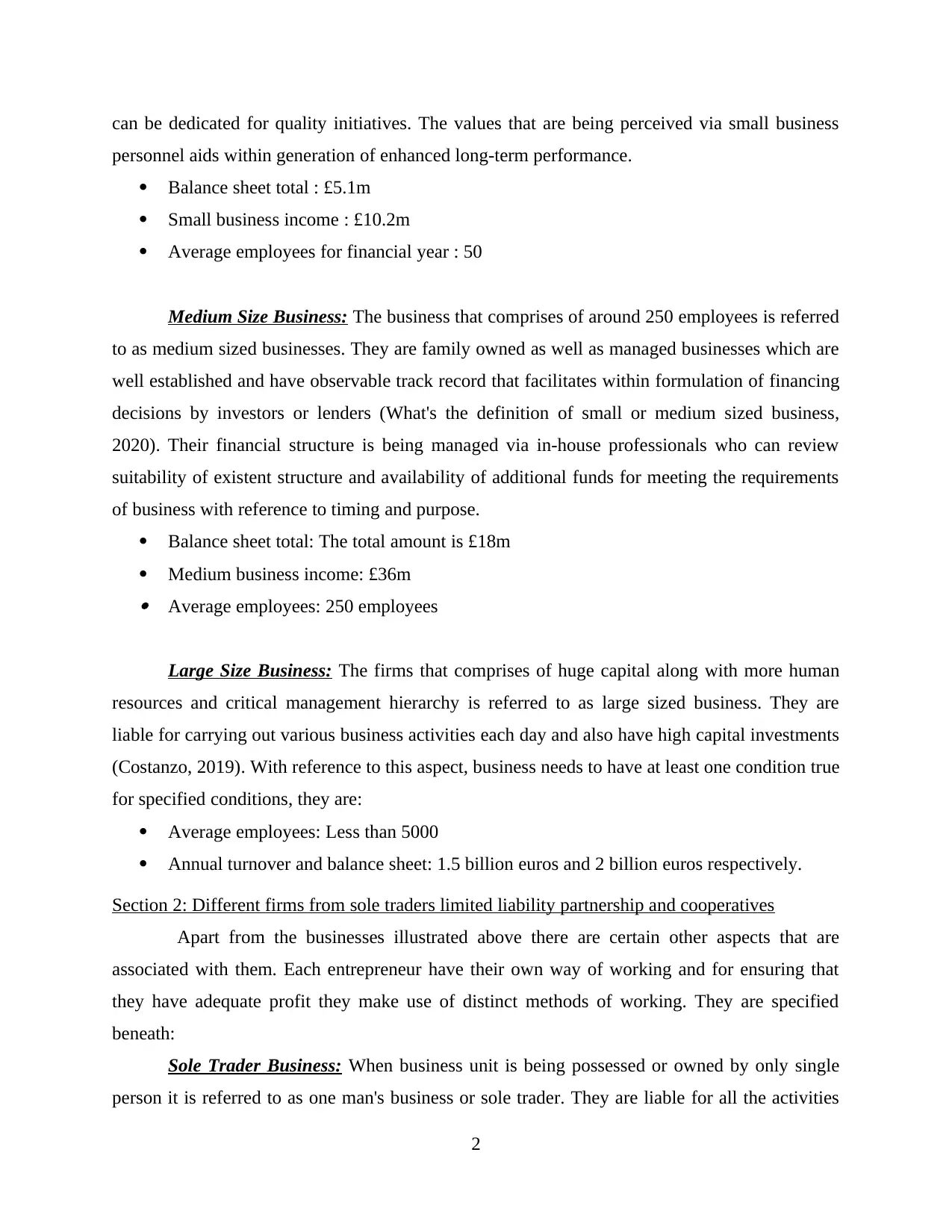
can be dedicated for quality initiatives. The values that are being perceived via small business
personnel aids within generation of enhanced long-term performance.
Balance sheet total : £5.1m
Small business income : £10.2m
Average employees for financial year : 50
Medium Size Business: The business that comprises of around 250 employees is referred
to as medium sized businesses. They are family owned as well as managed businesses which are
well established and have observable track record that facilitates within formulation of financing
decisions by investors or lenders (What's the definition of small or medium sized business,
2020). Their financial structure is being managed via in-house professionals who can review
suitability of existent structure and availability of additional funds for meeting the requirements
of business with reference to timing and purpose.
Balance sheet total: The total amount is £18m
Medium business income: £36m Average employees: 250 employees
Large Size Business: The firms that comprises of huge capital along with more human
resources and critical management hierarchy is referred to as large sized business. They are
liable for carrying out various business activities each day and also have high capital investments
(Costanzo, 2019). With reference to this aspect, business needs to have at least one condition true
for specified conditions, they are:
Average employees: Less than 5000
Annual turnover and balance sheet: 1.5 billion euros and 2 billion euros respectively.
Section 2: Different firms from sole traders limited liability partnership and cooperatives
Apart from the businesses illustrated above there are certain other aspects that are
associated with them. Each entrepreneur have their own way of working and for ensuring that
they have adequate profit they make use of distinct methods of working. They are specified
beneath:
Sole Trader Business: When business unit is being possessed or owned by only single
person it is referred to as one man's business or sole trader. They are liable for all the activities
2
personnel aids within generation of enhanced long-term performance.
Balance sheet total : £5.1m
Small business income : £10.2m
Average employees for financial year : 50
Medium Size Business: The business that comprises of around 250 employees is referred
to as medium sized businesses. They are family owned as well as managed businesses which are
well established and have observable track record that facilitates within formulation of financing
decisions by investors or lenders (What's the definition of small or medium sized business,
2020). Their financial structure is being managed via in-house professionals who can review
suitability of existent structure and availability of additional funds for meeting the requirements
of business with reference to timing and purpose.
Balance sheet total: The total amount is £18m
Medium business income: £36m Average employees: 250 employees
Large Size Business: The firms that comprises of huge capital along with more human
resources and critical management hierarchy is referred to as large sized business. They are
liable for carrying out various business activities each day and also have high capital investments
(Costanzo, 2019). With reference to this aspect, business needs to have at least one condition true
for specified conditions, they are:
Average employees: Less than 5000
Annual turnover and balance sheet: 1.5 billion euros and 2 billion euros respectively.
Section 2: Different firms from sole traders limited liability partnership and cooperatives
Apart from the businesses illustrated above there are certain other aspects that are
associated with them. Each entrepreneur have their own way of working and for ensuring that
they have adequate profit they make use of distinct methods of working. They are specified
beneath:
Sole Trader Business: When business unit is being possessed or owned by only single
person it is referred to as one man's business or sole trader. They are liable for all the activities
2
Paraphrase This Document
Need a fresh take? Get an instant paraphrase of this document with our AI Paraphraser
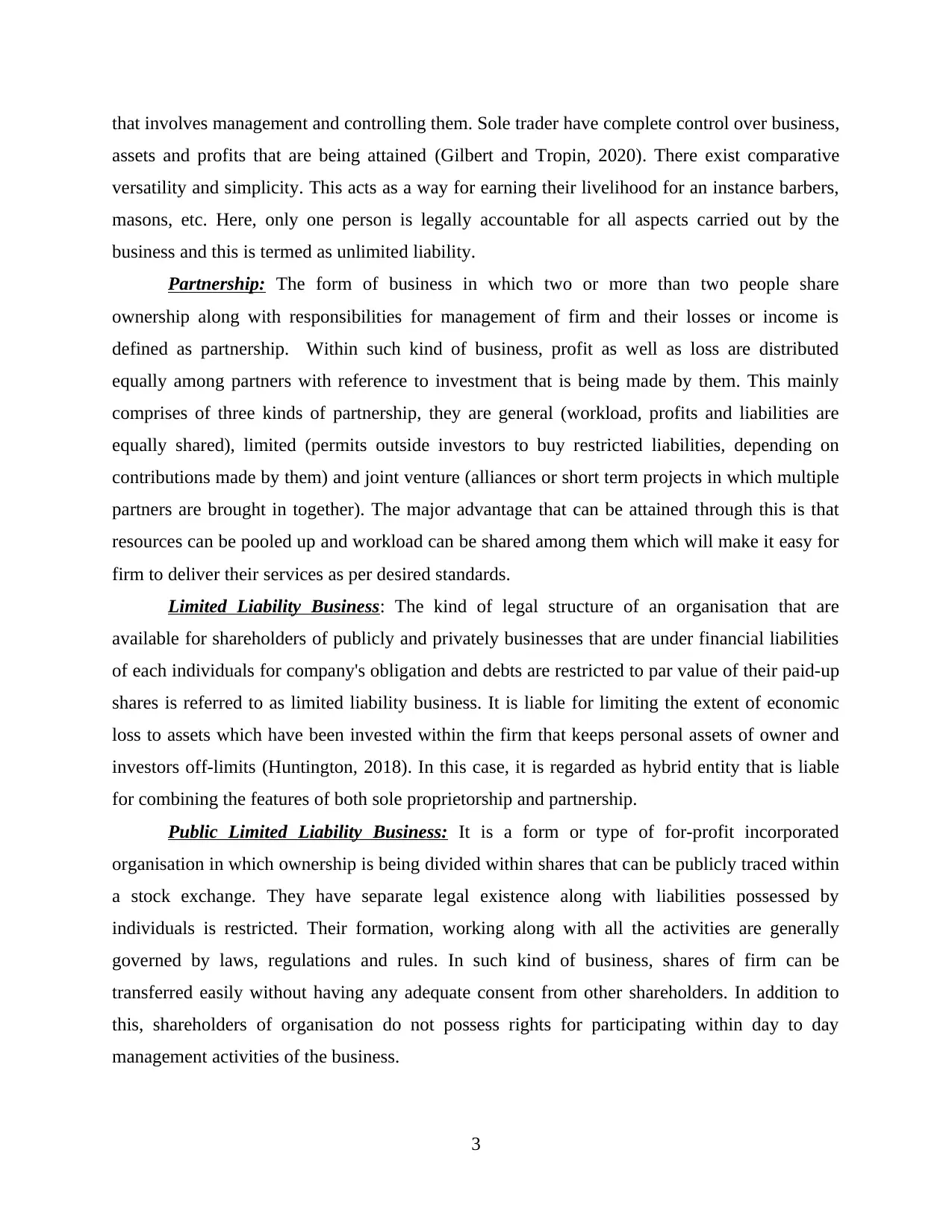
that involves management and controlling them. Sole trader have complete control over business,
assets and profits that are being attained (Gilbert and Tropin, 2020). There exist comparative
versatility and simplicity. This acts as a way for earning their livelihood for an instance barbers,
masons, etc. Here, only one person is legally accountable for all aspects carried out by the
business and this is termed as unlimited liability.
Partnership: The form of business in which two or more than two people share
ownership along with responsibilities for management of firm and their losses or income is
defined as partnership. Within such kind of business, profit as well as loss are distributed
equally among partners with reference to investment that is being made by them. This mainly
comprises of three kinds of partnership, they are general (workload, profits and liabilities are
equally shared), limited (permits outside investors to buy restricted liabilities, depending on
contributions made by them) and joint venture (alliances or short term projects in which multiple
partners are brought in together). The major advantage that can be attained through this is that
resources can be pooled up and workload can be shared among them which will make it easy for
firm to deliver their services as per desired standards.
Limited Liability Business: The kind of legal structure of an organisation that are
available for shareholders of publicly and privately businesses that are under financial liabilities
of each individuals for company's obligation and debts are restricted to par value of their paid-up
shares is referred to as limited liability business. It is liable for limiting the extent of economic
loss to assets which have been invested within the firm that keeps personal assets of owner and
investors off-limits (Huntington, 2018). In this case, it is regarded as hybrid entity that is liable
for combining the features of both sole proprietorship and partnership.
Public Limited Liability Business: It is a form or type of for-profit incorporated
organisation in which ownership is being divided within shares that can be publicly traced within
a stock exchange. They have separate legal existence along with liabilities possessed by
individuals is restricted. Their formation, working along with all the activities are generally
governed by laws, regulations and rules. In such kind of business, shares of firm can be
transferred easily without having any adequate consent from other shareholders. In addition to
this, shareholders of organisation do not possess rights for participating within day to day
management activities of the business.
3
assets and profits that are being attained (Gilbert and Tropin, 2020). There exist comparative
versatility and simplicity. This acts as a way for earning their livelihood for an instance barbers,
masons, etc. Here, only one person is legally accountable for all aspects carried out by the
business and this is termed as unlimited liability.
Partnership: The form of business in which two or more than two people share
ownership along with responsibilities for management of firm and their losses or income is
defined as partnership. Within such kind of business, profit as well as loss are distributed
equally among partners with reference to investment that is being made by them. This mainly
comprises of three kinds of partnership, they are general (workload, profits and liabilities are
equally shared), limited (permits outside investors to buy restricted liabilities, depending on
contributions made by them) and joint venture (alliances or short term projects in which multiple
partners are brought in together). The major advantage that can be attained through this is that
resources can be pooled up and workload can be shared among them which will make it easy for
firm to deliver their services as per desired standards.
Limited Liability Business: The kind of legal structure of an organisation that are
available for shareholders of publicly and privately businesses that are under financial liabilities
of each individuals for company's obligation and debts are restricted to par value of their paid-up
shares is referred to as limited liability business. It is liable for limiting the extent of economic
loss to assets which have been invested within the firm that keeps personal assets of owner and
investors off-limits (Huntington, 2018). In this case, it is regarded as hybrid entity that is liable
for combining the features of both sole proprietorship and partnership.
Public Limited Liability Business: It is a form or type of for-profit incorporated
organisation in which ownership is being divided within shares that can be publicly traced within
a stock exchange. They have separate legal existence along with liabilities possessed by
individuals is restricted. Their formation, working along with all the activities are generally
governed by laws, regulations and rules. In such kind of business, shares of firm can be
transferred easily without having any adequate consent from other shareholders. In addition to
this, shareholders of organisation do not possess rights for participating within day to day
management activities of the business.
3
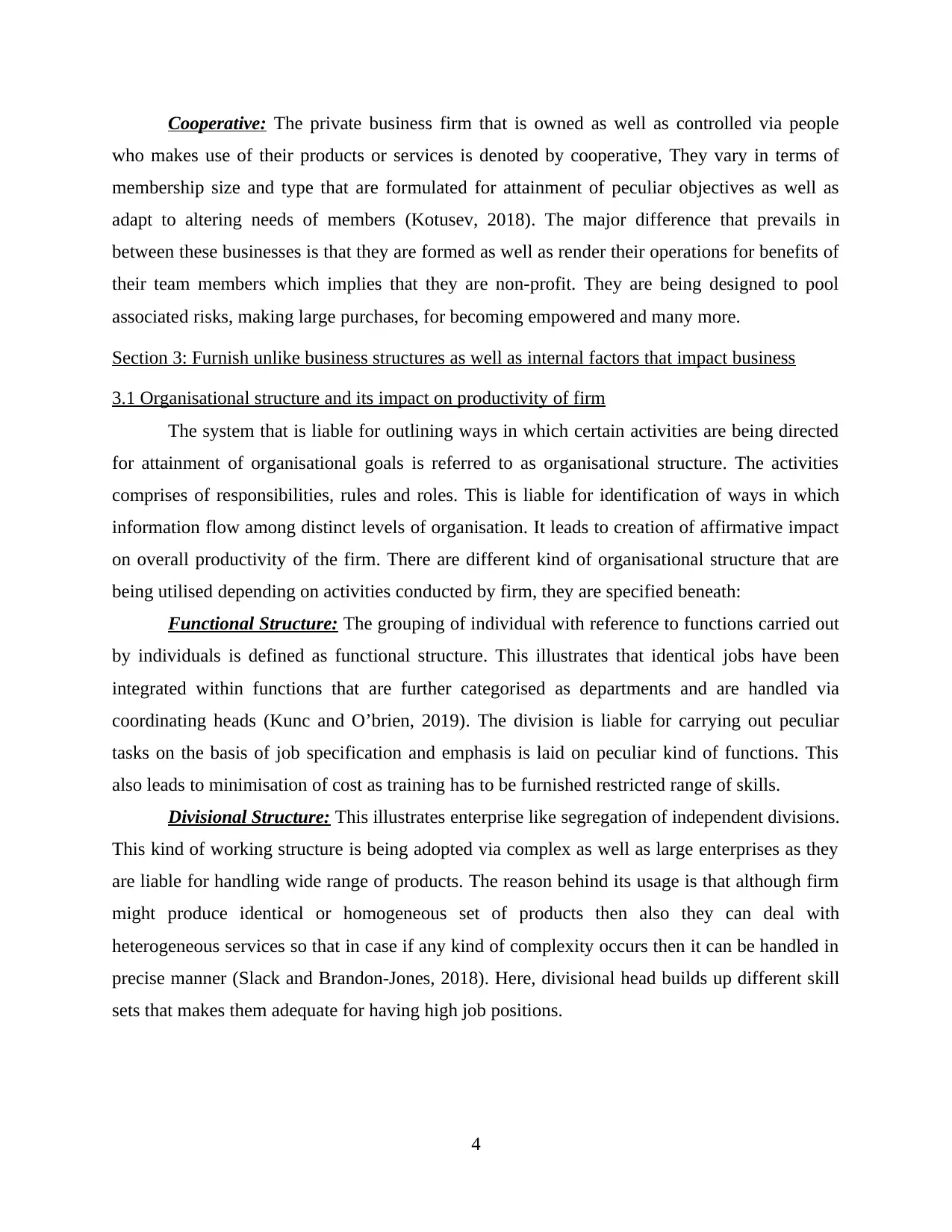
Cooperative: The private business firm that is owned as well as controlled via people
who makes use of their products or services is denoted by cooperative, They vary in terms of
membership size and type that are formulated for attainment of peculiar objectives as well as
adapt to altering needs of members (Kotusev, 2018). The major difference that prevails in
between these businesses is that they are formed as well as render their operations for benefits of
their team members which implies that they are non-profit. They are being designed to pool
associated risks, making large purchases, for becoming empowered and many more.
Section 3: Furnish unlike business structures as well as internal factors that impact business
3.1 Organisational structure and its impact on productivity of firm
The system that is liable for outlining ways in which certain activities are being directed
for attainment of organisational goals is referred to as organisational structure. The activities
comprises of responsibilities, rules and roles. This is liable for identification of ways in which
information flow among distinct levels of organisation. It leads to creation of affirmative impact
on overall productivity of the firm. There are different kind of organisational structure that are
being utilised depending on activities conducted by firm, they are specified beneath:
Functional Structure: The grouping of individual with reference to functions carried out
by individuals is defined as functional structure. This illustrates that identical jobs have been
integrated within functions that are further categorised as departments and are handled via
coordinating heads (Kunc and O’brien, 2019). The division is liable for carrying out peculiar
tasks on the basis of job specification and emphasis is laid on peculiar kind of functions. This
also leads to minimisation of cost as training has to be furnished restricted range of skills.
Divisional Structure: This illustrates enterprise like segregation of independent divisions.
This kind of working structure is being adopted via complex as well as large enterprises as they
are liable for handling wide range of products. The reason behind its usage is that although firm
might produce identical or homogeneous set of products then also they can deal with
heterogeneous services so that in case if any kind of complexity occurs then it can be handled in
precise manner (Slack and Brandon-Jones, 2018). Here, divisional head builds up different skill
sets that makes them adequate for having high job positions.
4
who makes use of their products or services is denoted by cooperative, They vary in terms of
membership size and type that are formulated for attainment of peculiar objectives as well as
adapt to altering needs of members (Kotusev, 2018). The major difference that prevails in
between these businesses is that they are formed as well as render their operations for benefits of
their team members which implies that they are non-profit. They are being designed to pool
associated risks, making large purchases, for becoming empowered and many more.
Section 3: Furnish unlike business structures as well as internal factors that impact business
3.1 Organisational structure and its impact on productivity of firm
The system that is liable for outlining ways in which certain activities are being directed
for attainment of organisational goals is referred to as organisational structure. The activities
comprises of responsibilities, rules and roles. This is liable for identification of ways in which
information flow among distinct levels of organisation. It leads to creation of affirmative impact
on overall productivity of the firm. There are different kind of organisational structure that are
being utilised depending on activities conducted by firm, they are specified beneath:
Functional Structure: The grouping of individual with reference to functions carried out
by individuals is defined as functional structure. This illustrates that identical jobs have been
integrated within functions that are further categorised as departments and are handled via
coordinating heads (Kunc and O’brien, 2019). The division is liable for carrying out peculiar
tasks on the basis of job specification and emphasis is laid on peculiar kind of functions. This
also leads to minimisation of cost as training has to be furnished restricted range of skills.
Divisional Structure: This illustrates enterprise like segregation of independent divisions.
This kind of working structure is being adopted via complex as well as large enterprises as they
are liable for handling wide range of products. The reason behind its usage is that although firm
might produce identical or homogeneous set of products then also they can deal with
heterogeneous services so that in case if any kind of complexity occurs then it can be handled in
precise manner (Slack and Brandon-Jones, 2018). Here, divisional head builds up different skill
sets that makes them adequate for having high job positions.
4
⊘ This is a preview!⊘
Do you want full access?
Subscribe today to unlock all pages.

Trusted by 1+ million students worldwide
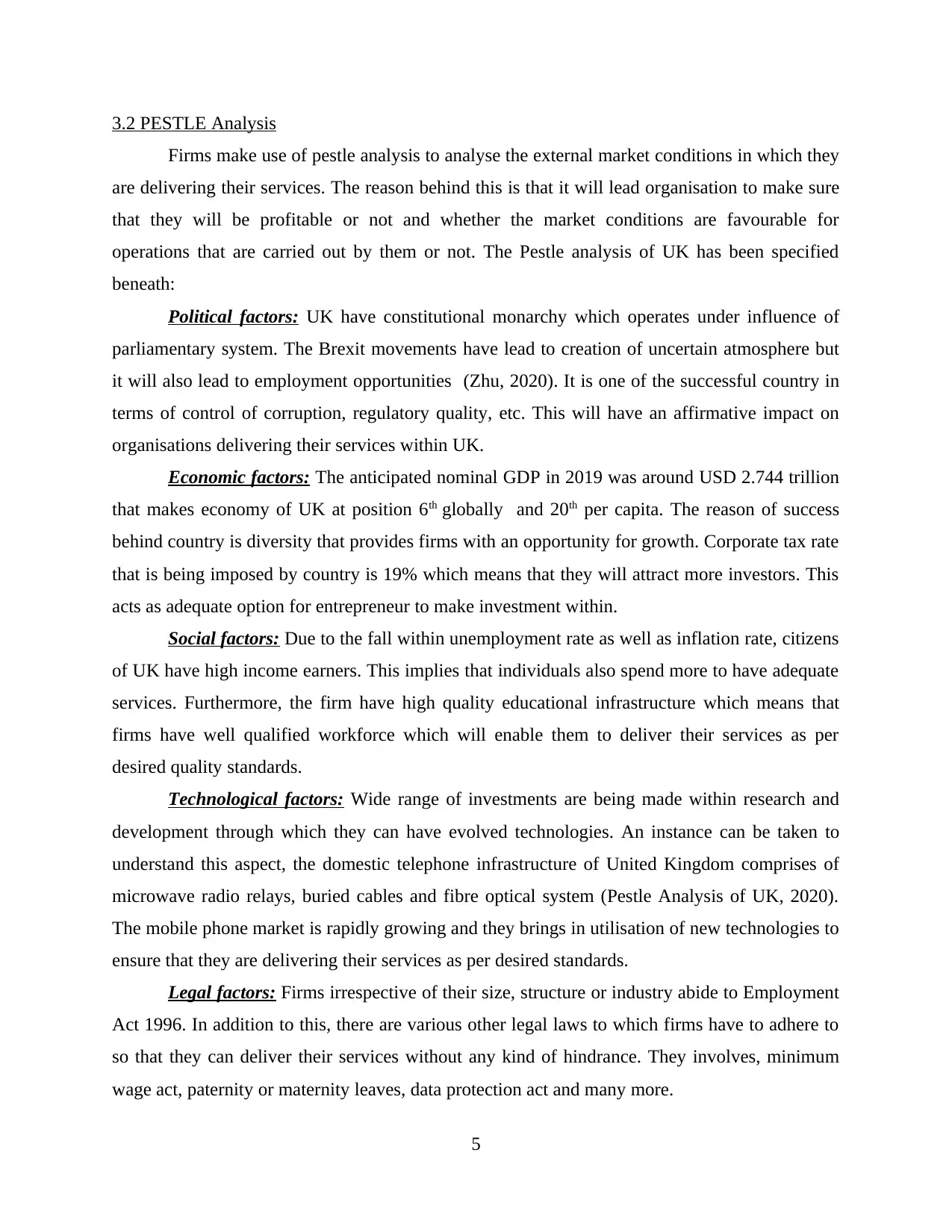
3.2 PESTLE Analysis
Firms make use of pestle analysis to analyse the external market conditions in which they
are delivering their services. The reason behind this is that it will lead organisation to make sure
that they will be profitable or not and whether the market conditions are favourable for
operations that are carried out by them or not. The Pestle analysis of UK has been specified
beneath:
Political factors: UK have constitutional monarchy which operates under influence of
parliamentary system. The Brexit movements have lead to creation of uncertain atmosphere but
it will also lead to employment opportunities (Zhu, 2020). It is one of the successful country in
terms of control of corruption, regulatory quality, etc. This will have an affirmative impact on
organisations delivering their services within UK.
Economic factors: The anticipated nominal GDP in 2019 was around USD 2.744 trillion
that makes economy of UK at position 6th globally and 20th per capita. The reason of success
behind country is diversity that provides firms with an opportunity for growth. Corporate tax rate
that is being imposed by country is 19% which means that they will attract more investors. This
acts as adequate option for entrepreneur to make investment within.
Social factors: Due to the fall within unemployment rate as well as inflation rate, citizens
of UK have high income earners. This implies that individuals also spend more to have adequate
services. Furthermore, the firm have high quality educational infrastructure which means that
firms have well qualified workforce which will enable them to deliver their services as per
desired quality standards.
Technological factors: Wide range of investments are being made within research and
development through which they can have evolved technologies. An instance can be taken to
understand this aspect, the domestic telephone infrastructure of United Kingdom comprises of
microwave radio relays, buried cables and fibre optical system (Pestle Analysis of UK, 2020).
The mobile phone market is rapidly growing and they brings in utilisation of new technologies to
ensure that they are delivering their services as per desired standards.
Legal factors: Firms irrespective of their size, structure or industry abide to Employment
Act 1996. In addition to this, there are various other legal laws to which firms have to adhere to
so that they can deliver their services without any kind of hindrance. They involves, minimum
wage act, paternity or maternity leaves, data protection act and many more.
5
Firms make use of pestle analysis to analyse the external market conditions in which they
are delivering their services. The reason behind this is that it will lead organisation to make sure
that they will be profitable or not and whether the market conditions are favourable for
operations that are carried out by them or not. The Pestle analysis of UK has been specified
beneath:
Political factors: UK have constitutional monarchy which operates under influence of
parliamentary system. The Brexit movements have lead to creation of uncertain atmosphere but
it will also lead to employment opportunities (Zhu, 2020). It is one of the successful country in
terms of control of corruption, regulatory quality, etc. This will have an affirmative impact on
organisations delivering their services within UK.
Economic factors: The anticipated nominal GDP in 2019 was around USD 2.744 trillion
that makes economy of UK at position 6th globally and 20th per capita. The reason of success
behind country is diversity that provides firms with an opportunity for growth. Corporate tax rate
that is being imposed by country is 19% which means that they will attract more investors. This
acts as adequate option for entrepreneur to make investment within.
Social factors: Due to the fall within unemployment rate as well as inflation rate, citizens
of UK have high income earners. This implies that individuals also spend more to have adequate
services. Furthermore, the firm have high quality educational infrastructure which means that
firms have well qualified workforce which will enable them to deliver their services as per
desired quality standards.
Technological factors: Wide range of investments are being made within research and
development through which they can have evolved technologies. An instance can be taken to
understand this aspect, the domestic telephone infrastructure of United Kingdom comprises of
microwave radio relays, buried cables and fibre optical system (Pestle Analysis of UK, 2020).
The mobile phone market is rapidly growing and they brings in utilisation of new technologies to
ensure that they are delivering their services as per desired standards.
Legal factors: Firms irrespective of their size, structure or industry abide to Employment
Act 1996. In addition to this, there are various other legal laws to which firms have to adhere to
so that they can deliver their services without any kind of hindrance. They involves, minimum
wage act, paternity or maternity leaves, data protection act and many more.
5
Paraphrase This Document
Need a fresh take? Get an instant paraphrase of this document with our AI Paraphraser
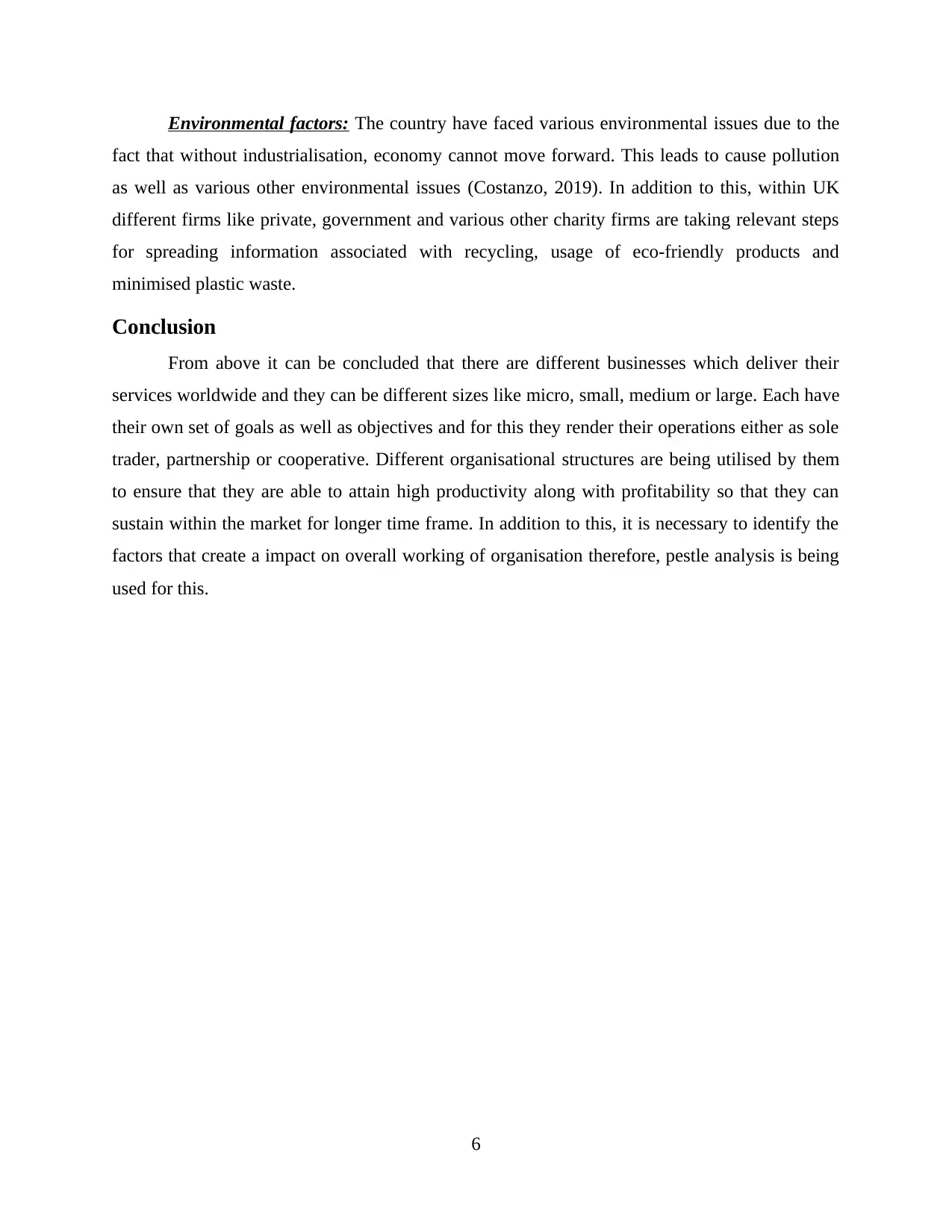
Environmental factors: The country have faced various environmental issues due to the
fact that without industrialisation, economy cannot move forward. This leads to cause pollution
as well as various other environmental issues (Costanzo, 2019). In addition to this, within UK
different firms like private, government and various other charity firms are taking relevant steps
for spreading information associated with recycling, usage of eco-friendly products and
minimised plastic waste.
Conclusion
From above it can be concluded that there are different businesses which deliver their
services worldwide and they can be different sizes like micro, small, medium or large. Each have
their own set of goals as well as objectives and for this they render their operations either as sole
trader, partnership or cooperative. Different organisational structures are being utilised by them
to ensure that they are able to attain high productivity along with profitability so that they can
sustain within the market for longer time frame. In addition to this, it is necessary to identify the
factors that create a impact on overall working of organisation therefore, pestle analysis is being
used for this.
6
fact that without industrialisation, economy cannot move forward. This leads to cause pollution
as well as various other environmental issues (Costanzo, 2019). In addition to this, within UK
different firms like private, government and various other charity firms are taking relevant steps
for spreading information associated with recycling, usage of eco-friendly products and
minimised plastic waste.
Conclusion
From above it can be concluded that there are different businesses which deliver their
services worldwide and they can be different sizes like micro, small, medium or large. Each have
their own set of goals as well as objectives and for this they render their operations either as sole
trader, partnership or cooperative. Different organisational structures are being utilised by them
to ensure that they are able to attain high productivity along with profitability so that they can
sustain within the market for longer time frame. In addition to this, it is necessary to identify the
factors that create a impact on overall working of organisation therefore, pestle analysis is being
used for this.
6
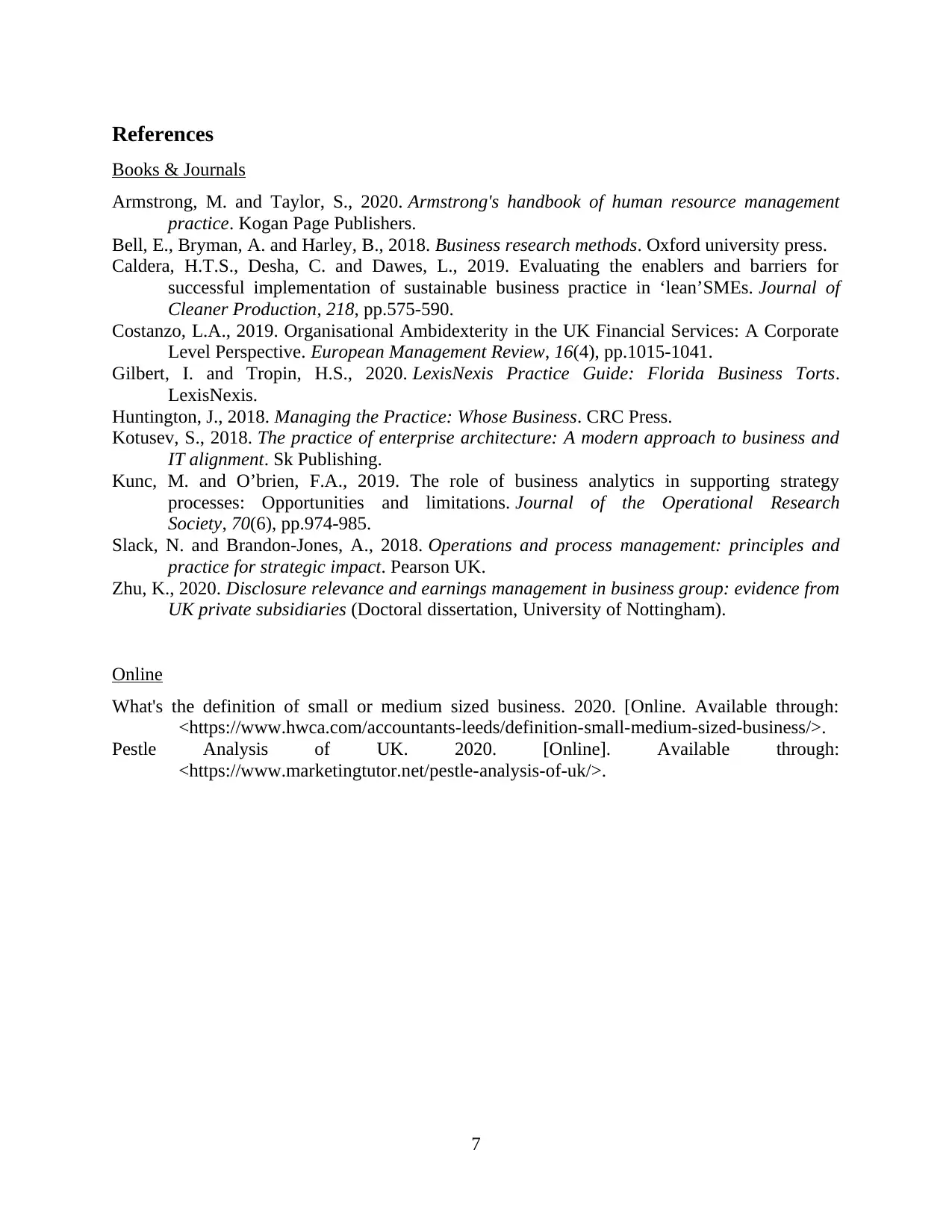
References
Books & Journals
Armstrong, M. and Taylor, S., 2020. Armstrong's handbook of human resource management
practice. Kogan Page Publishers.
Bell, E., Bryman, A. and Harley, B., 2018. Business research methods. Oxford university press.
Caldera, H.T.S., Desha, C. and Dawes, L., 2019. Evaluating the enablers and barriers for
successful implementation of sustainable business practice in ‘lean’SMEs. Journal of
Cleaner Production, 218, pp.575-590.
Costanzo, L.A., 2019. Organisational Ambidexterity in the UK Financial Services: A Corporate
Level Perspective. European Management Review, 16(4), pp.1015-1041.
Gilbert, I. and Tropin, H.S., 2020. LexisNexis Practice Guide: Florida Business Torts.
LexisNexis.
Huntington, J., 2018. Managing the Practice: Whose Business. CRC Press.
Kotusev, S., 2018. The practice of enterprise architecture: A modern approach to business and
IT alignment. Sk Publishing.
Kunc, M. and O’brien, F.A., 2019. The role of business analytics in supporting strategy
processes: Opportunities and limitations. Journal of the Operational Research
Society, 70(6), pp.974-985.
Slack, N. and Brandon-Jones, A., 2018. Operations and process management: principles and
practice for strategic impact. Pearson UK.
Zhu, K., 2020. Disclosure relevance and earnings management in business group: evidence from
UK private subsidiaries (Doctoral dissertation, University of Nottingham).
Online
What's the definition of small or medium sized business. 2020. [Online. Available through:
<https://www.hwca.com/accountants-leeds/definition-small-medium-sized-business/>.
Pestle Analysis of UK. 2020. [Online]. Available through:
<https://www.marketingtutor.net/pestle-analysis-of-uk/>.
7
Books & Journals
Armstrong, M. and Taylor, S., 2020. Armstrong's handbook of human resource management
practice. Kogan Page Publishers.
Bell, E., Bryman, A. and Harley, B., 2018. Business research methods. Oxford university press.
Caldera, H.T.S., Desha, C. and Dawes, L., 2019. Evaluating the enablers and barriers for
successful implementation of sustainable business practice in ‘lean’SMEs. Journal of
Cleaner Production, 218, pp.575-590.
Costanzo, L.A., 2019. Organisational Ambidexterity in the UK Financial Services: A Corporate
Level Perspective. European Management Review, 16(4), pp.1015-1041.
Gilbert, I. and Tropin, H.S., 2020. LexisNexis Practice Guide: Florida Business Torts.
LexisNexis.
Huntington, J., 2018. Managing the Practice: Whose Business. CRC Press.
Kotusev, S., 2018. The practice of enterprise architecture: A modern approach to business and
IT alignment. Sk Publishing.
Kunc, M. and O’brien, F.A., 2019. The role of business analytics in supporting strategy
processes: Opportunities and limitations. Journal of the Operational Research
Society, 70(6), pp.974-985.
Slack, N. and Brandon-Jones, A., 2018. Operations and process management: principles and
practice for strategic impact. Pearson UK.
Zhu, K., 2020. Disclosure relevance and earnings management in business group: evidence from
UK private subsidiaries (Doctoral dissertation, University of Nottingham).
Online
What's the definition of small or medium sized business. 2020. [Online. Available through:
<https://www.hwca.com/accountants-leeds/definition-small-medium-sized-business/>.
Pestle Analysis of UK. 2020. [Online]. Available through:
<https://www.marketingtutor.net/pestle-analysis-of-uk/>.
7
⊘ This is a preview!⊘
Do you want full access?
Subscribe today to unlock all pages.

Trusted by 1+ million students worldwide
1 out of 9
Related Documents
Your All-in-One AI-Powered Toolkit for Academic Success.
+13062052269
info@desklib.com
Available 24*7 on WhatsApp / Email
![[object Object]](/_next/static/media/star-bottom.7253800d.svg)
Unlock your academic potential
Copyright © 2020–2025 A2Z Services. All Rights Reserved. Developed and managed by ZUCOL.




